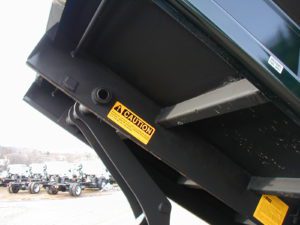What is a Pool?

A “pool” is a factory authorized alternative source of commercially upfitted vehicles. We maintain a large inventory of chassis both with and without bodies as an inventory source for dealerships, 365 days a year. It is because of our large stock availability that we can deliver it to dealerships quickly.
A pool does not own the chassis, but they are floor planned by the factory, or another bank source in the same manner as a dealership. Because we do not own the vehicles, we cannot sell them directly to the end-user. We do, however, work directly with the end-user to custom tailor bodies to their specific requirements.
Dejana maintains pool inventory for Chevrolet, GMC, Ford, and Ram. We are closely monitored by the factories in order to meet their quality assurance standards
Certification
Once a body has been installed on a cab and chassis this sticker is affixed on the driver’s door jamb. It states:
- Date of manufacture
- Who manufactured the chassis,
- Month and year the vehicle was made by the factory
- GVWR of the chassis (Gross Vehicle Weight Rating)
- Front GAWR (Front Gross Axle Weight Rating)
- Front & rear tire size, correct inflation setting, how many tires per axle, and the wheel size
- Date completed and the serial number of the vehicle
About Chassis

What is the Cab?
- The “cab” is the part of the truck where the passengers ride.
- A regular cab has 2 doors and one three passenger seat.
- An extended cab has 4 doors, a full-size front seat, and a smaller rear seat and can seat a maximum of 6 people.
- A crew cab has 4 full-size doors, 2 full-size bench seats and can seat a maximum of 6 people comfortably.
What is Chassis?
- The chassis is the part of the truck starting from the rear of the back window to the end of the frame.
- This is the part of the truck that we mount the bodies on.
What is a cutaway?
 A “cutaway” is a full-size van that the manufacturer stopped building from just behind the driver and passenger seat.
A “cutaway” is a full-size van that the manufacturer stopped building from just behind the driver and passenger seat.- These can be either SRW (single rear wheel) or DRW (dual rear wheel).
- They can come in different lengths or wheelbases.
- They typically have enclosed “service bodies” or “high cubes” installed on them.
- These are all called “incomplete vehicles,” and Dejana is a “final stage manufacturer.”
What is the Wheelbase?
- The wheelbase the distance measurement from the midpoint of front axle to the midpoint of the rear axle. The wheelbase measurement tells us how long the truck chassis is.
About Payload & Gross Vehicle Weight
What is Payload?
- Payload is the measurement in pounds of how much material, equipment & tools that a vehicle can carry without being over the vehicles maximum Gross Vehicle Weight Rating (GVWR).
- Calculating payload is an essential part of any commercial truck upfit
What is Gross Vehicle Weight Rating (GVWR)?
- GVWR stands for “Gross Vehicle Weight Rating”
- This is the most that a vehicle can weigh including:
- The weight of the cab and chassis
- The weight of body you put on it
- The weight of your passengers
- The tools and equipment you carry
- The product, material you put in it.
Class and Gross Vehicle Weight Rating GVWR…
- The industry puts vehicles into “classes” based on their GVW or Gross Vehicle Weight Rating.
- Class 1 up to 6,000 lbs
- Class 2 up to 10,000 lbs
- Class 3 up to 14,000 lbs
- Class 4 up to 16,000 lbs
- Class 5 up to 19,500 lbs
- Class 6 up to 26,000 lbs
- Class 7 up to 33,000 lbs
- Class 8 anything over 33K
- Vehicles in Classes 1 thru 5 are considered “light duty” trucks/vans.
- Vehicles in Classes 6 and 7 are considered “medium-duty” trucks or vans.
- Typically vehicles under 26,001 lbs can be driven with a regular drivers license.
- Vehicles over 26,001 lbs require a CDL…Commercial Drivers License.
- Some Class 5 trucks towing trailers over 10K might need CDLs as well
Body Weight info…
- Body weight info can be obtained from the specifications presented here on the Dejana website based on the unit that you are interested in. In general, here are some rules of thumb…
- Utility Bodies
- 8 Ft SRW for use on pickup box removal trucks 1,200 lbs
- 9 Ft DRW for use on 60” CA Cab & Chassis 1,500 lbs
- 11 Ft DRW for use on 84” CA Cab and Chassis 1,700 lbs
- Platforms
- Platforms (no racks) weight approx. 100 lbs per Ft of length
- 9 Feet long X 100 Lbs = 900 Lbs
- Add 500 Lbs if the body is designed to dump
- Rack Bodies
- Rack bodies weigh approx. 130 lbs per Ft of length
- 10 Feet long X 130 Lbs = 1,300 Lbs
- Add 500 Lbs if the body is designed to dump
- Solid Side/Grain Bodies
- Solid Side Bodies weight approx. 215 lbs per Ft of length
- 10 Feet long X 215 Lbs = 2,150 Lbs
- This body almost always dumps so the “hoist” is included.
- Dump Bodies
- 9 Ft 2-3 Yard 1,985 lbs
- 9 Ft 3-4 Yard 2,080 lbs
- 11 Ft 2-3 Yard 2,195 lbs
- 11 Ft 3-4 Yard 2,300 lbs (including hoist)
Passenger Weight…
- Assume 150lbs. per person as a guideline
Tools & Equipment Weight…
- As part of your estimate, remember to include the approximate weights for add-ons such as snow plows, liftgates, compressors, tool racks and any tools or items that may be carried in the cab.
Weights of Materials…
- Calculating the approximate weights of materials that you may be carrying can be a challenging task. But when evaluating a commercial truck for your needs, it is extremely important that you know how much material you’ll be able to carry when the upfit is complete!
- As an estimate, consider the following weights per cubic yard of material. Keep in mind that you will need to multiply this number by the yard capacity of your body. If, for example, you are considering a 3 yard dump body, then these estimates would need to be multiplied by 3.
- Crushed stone 2700 lbs
- Loose earth 2050 lbs
- Dry gravel 2565 lbs
- Wet gravel 3375 lbs
- Mulch 500 – 800 lbs
- Dry sand 2970 lbs
- Wet sand 3375 lbs
- Crushed marble 2565 lbs
- Rock salt 1350 lbs
- Sandstone 2325 lbs
- Trap rock 5050 lbs
About Pickup Trucks
½ Ton Pickup Trucks
- Usually purchased by homeowners and businesses that do not carry or pull heavy loads. GVW range is typically 6,000 to 7,000 lbs.

- Available in 4X2 and 4X4 models. In regular cab, extended cab and crew cab, in both short bed (6.5’long) and long beds (8’ long).
- They are only available as a single rear wheel (SRW). One tire on each side of rear axle.
- Currently, you can not take the bed off of these trucks to make them utility bodies or dump trucks.
- Their payloads (what they can carry) ranges from 1,500 lbs to 2,500 lbs.
- Not all engines & transmissions are available.
¾ Ton Pickup Trucks Usually purchased by businesses that may need to tow or carry heavier loads.
- Available in 4X2 and 4X4 models. In regular cab, extended cab, and crew cab, and are usually ordered as long beds (8’ long)
- They are only available as a single rear wheel (SRW).
- You can take the bed off of these trucks to make them utility bodies or rack bodies, but not dump bodies.
- Their payloads (what they can carry) ranges from 2,500 lbs to 4,000 lbs.
- V-8 gas & diesel motors are now available.
1 Ton Pickup Trucks
- Usually purchased by businesses that may need to tow or carry much heavier loads.
- Available in 4X2 and 4X4 models. In regular cab, extended cab, and crew cab, and are usually ordered as long beds (8’ long).
- They are available as a single rear wheel (SRW) and dual rear wheel (DRW).
- You can take the bed off of these trucks to make them utility bodies or rack bodies, but not dump bodies.
- Their payloads (what they can carry) ranges from 3,300 lbs to 4,100 lbs.
- V-8 gas & diesel motors are now available.
What Can You Do With Pickup Trucks?
- On ¾ ton pickup trucks we can install:
- 7 ½ foot snow plow
- Tailgate style salt and sand spreaders
- SRW utility bodies
- Light capacity liftgates
- On 1 ton pickups we can install:
- Up to 81/2 foot plow
- Hopper style salt and sand spreader
- Larger capacity liftgates
- On 1-ton pickup trucks we can install:
- Up to 81/2 foot plow
- Hopper style salt and sand spreader
- Larger capacity liftgates
About Service Body & Utility Trucks
 What You Need to Know about Service (aka Utility) Body Trucks…
What You Need to Know about Service (aka Utility) Body Trucks…
- Utility bodies or Service Body can be installed on a ¾ or 1 ton pickups.
- The width and length of the body is determined by the chassis you use.
- Pickups take shorter, narrower bodies. Chassis take longer and wider bodies.
- They are always “fixed” and never dump. Although a dump insert can be installed.
- Most bodies have 2 vertical compartments & 1 horizontal over the rear wheel wells.

- There is at least 48.5” of floor width. Compartment depths vary from 14” to 20”.
- Traditional bodies are square, but there are also more “sleek” contoured models available.
- Flip tops, ladder racks, cranes, liftgates and canopy roofs are popular options.
- Popular applications include: A/C contractors, building contractors, electrical contractors, gas utilities, carpenters, painters, roofers, remodelers, garage door installers.
About Platform Trucks & Racks

 What You Need to Know about Platform Truck, Rack & Solid Side Bodies…
What You Need to Know about Platform Truck, Rack & Solid Side Bodies…
- They can be installed on 3/4 ton or higher GVW SRW or DRW chassis.
- The body length & width is determined by the “CA” & # of rear tires on the chassis.
- The height of the racks (40” is Std) are determined by the GVW of the chassis.
- 9 Ft bodies are installed on 60” CA chassis. 12 Ft are installed on 84” CA chassis.
- Floors can be made of wood, smooth steel or tread plate style steel.
- Racks and platforms can be fixed or can dump. Grain sides almost always dump.
- The bodies are raised by an electric motor pumping hydraulic fluid thru a “hoist”.
- Popular applications include fencing, HVAC, insulation, flooring, kitchen, moving, awning and canopy, landscape, nurseries, lumber, delivery, roofers.
About Dump Bodies
What You Need to Know about a Dump Body…
 • A Dump Body can only be installed on one ton or higher GVW chassis with dual rear wheels.
• A Dump Body can only be installed on one ton or higher GVW chassis with dual rear wheels.
• The length of the dump body is determined by the “CA” of the chassis you are using.
• The height of the sides of the dump body are determined by the GVW of the chassis.
• A 9 foot dump body are installed on 60” CA chassis in 2-3 or 3-4 yard capacities.
• 11 foot dump bodies are installed on 84” CA chassis in 2-3 or 3-4 yard capacities.
• A “yard” is a cubic yard and measures 3’ X 3’ X 3”.
• A dump body is raised by an electric motor pumping hydraulic fluid thru a “hoist.”
• Popular applications include: building contractors, landscapers, demolition contractors, nurseries, sand and gravel, remodelers, masonry contractors, home builders.
About Understructures
 There are a number of different types of understructures on the market, and knowing what to look for can make a big difference further down the road.
There are a number of different types of understructures on the market, and knowing what to look for can make a big difference further down the road.
Pictured to the right is a “stacked” or “ladder type” frame. It is made up of “long sills” (running up and down) and “cross members” (running L-R). The long sills are 5” high and made of structural steel.
The cross members going L-R are made of 3” high structural I-Beam design and are on 16” centers.
Note: There are also gussets on every other cross member for additional strength.
This is the picture of an “interlaced frame.”
Note: that the cross members run through the long sills which weaken the structural integrity.
The long sills and cross members are also made of formed steel (a flat piece of steel bent to the shape needed) bending weakens the steel
 What’s important is your truck is built by an upfitter that is authorized, certified, and insured. It also helps if you understand the fundamentals of things like chassis specifications, GVW & payload. After all, your brand new dump truck may drive great, but is it underpowered for a 3-4 yard body with gravel in it?
What’s important is your truck is built by an upfitter that is authorized, certified, and insured. It also helps if you understand the fundamentals of things like chassis specifications, GVW & payload. After all, your brand new dump truck may drive great, but is it underpowered for a 3-4 yard body with gravel in it?
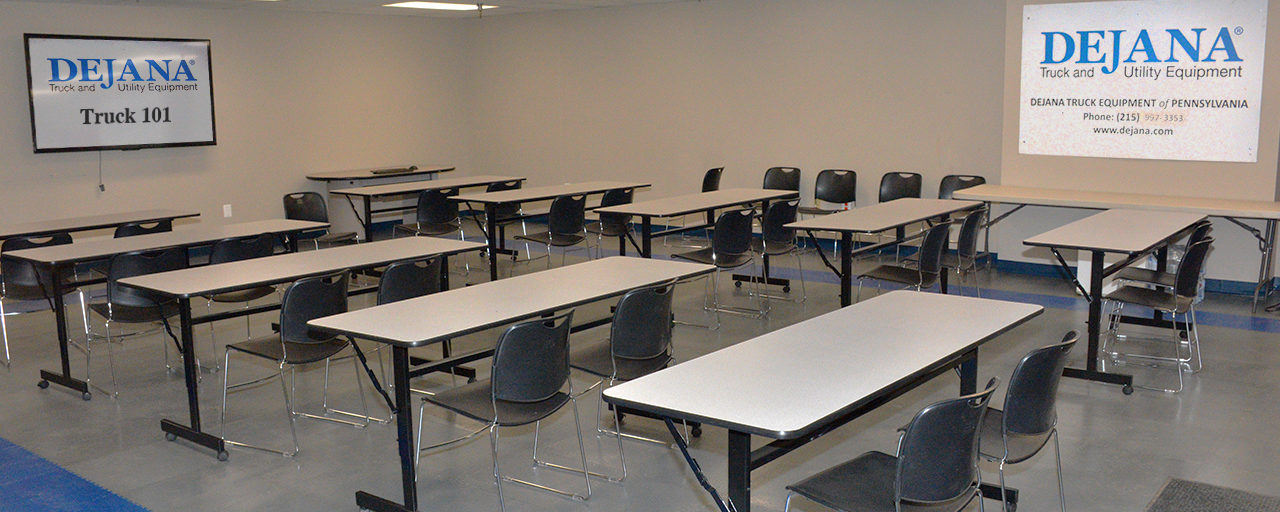



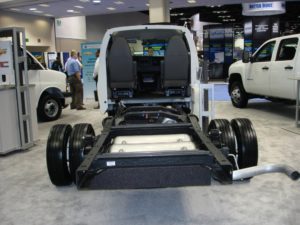 A “cutaway” is a full-size van that the manufacturer stopped building from just behind the driver and passenger seat.
A “cutaway” is a full-size van that the manufacturer stopped building from just behind the driver and passenger seat.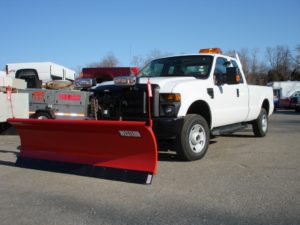
 What You Need to Know about Service (aka Utility) Body Trucks…
What You Need to Know about Service (aka Utility) Body Trucks…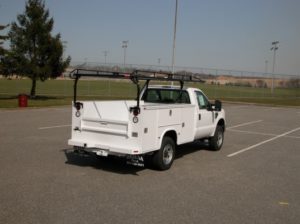

 What You Need to Know about Platform Truck, Rack & Solid Side Bodies…
What You Need to Know about Platform Truck, Rack & Solid Side Bodies…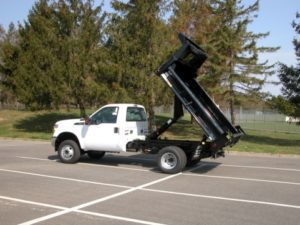 • A Dump Body can only be installed on one ton or higher GVW chassis with dual rear wheels.
• A Dump Body can only be installed on one ton or higher GVW chassis with dual rear wheels. There are a number of different types of understructures on the market, and knowing what to look for can make a big difference further down the road.
There are a number of different types of understructures on the market, and knowing what to look for can make a big difference further down the road.